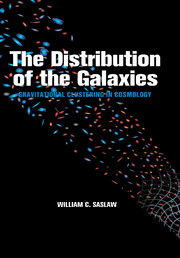Book contents
- Frontmatter
- Contents
- Prologue
- Part I Historical
- Part II Descriptions of Clustering
- Part III Gravity and Correlation Functions
- 16 The Growth of Correlations: I. A Fluid Description
- 17 The Growth of Correlations: II. A Particle Description
- 18 General Correlation Properties
- 19 Computer Simulations
- 20 Simulations and Observations of Two-Particle Correlations
- Part IV Gravity and Distribution Functions
- Part V Computer Experiments for Distribution Functions
- Part VI Observations of Distribution Functions
- Part VII Future Unfoldings
- Bibliography
- Index
19 - Computer Simulations
Published online by Cambridge University Press: 19 January 2010
- Frontmatter
- Contents
- Prologue
- Part I Historical
- Part II Descriptions of Clustering
- Part III Gravity and Correlation Functions
- 16 The Growth of Correlations: I. A Fluid Description
- 17 The Growth of Correlations: II. A Particle Description
- 18 General Correlation Properties
- 19 Computer Simulations
- 20 Simulations and Observations of Two-Particle Correlations
- Part IV Gravity and Distribution Functions
- Part V Computer Experiments for Distribution Functions
- Part VI Observations of Distribution Functions
- Part VII Future Unfoldings
- Bibliography
- Index
Summary
All computer simulations sacrifice
information to the great God Time.
Direct Methods
For inspiring new insights into galaxy clustering, for testing our understanding of gravitational many-body physics, and for detailed comparisons with observation, nothing works better than computer experiments. But they also have trade-offs and dangers. The trade-offs are among detailed physical information, computational speed, and number of physical particles. The dangers are lack of uniqueness and a tendency to examine only a small range of models based just on different parameters rather than on different basic ideas.
A variety of numerical techniques, all compromises, have been developed for different types of problems. The simplest problem considers the evolution of a distribution of N points with the same or different masses in the background of an expanding universe. We shall call this the cosmological many-body problem. Each point mass represents a galaxy and its associated halo. This is a good approximation if we are not concerned with galaxies' tidal interactions and mergers, or with inhomogeneous dynamically important intergalactic matter. Such complications can be added using other techniques to determine their significance.
Cosmological many-body problems are usually solved by integrating all the N particles' equations of motion. This is the direct method. Since only particle–particle interactions occur, it is also called the particle–particle (PP) method. Though direct, it is not straightforward. There are N equations, each with N terms, leading to ∼N2 operations. Moreover, when particles come close together, their high accelerations require short time steps.
- Type
- Chapter
- Information
- The Distribution of the GalaxiesGravitational Clustering in Cosmology, pp. 227 - 233Publisher: Cambridge University PressPrint publication year: 1999



